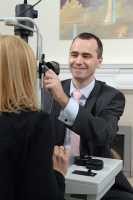06 Sep Patients With Glaucoma Can Be Taught To Measure Their Own Intraocular Pressure
MedicalResearch.com Interview with:
Andrew Tatham, FRCOphth
Consultant Ophthalmologist
Princess Alexandra Eye Pavilion and Department of Ophthalmology
University of Edinburgh, Scotland
MedicalResearch.com: What is the background for this study?
Response: Raised intraocular pressure (IOP) is the major risk factor for the development of glaucoma, the most common cause of irreversible blindness, with lowering IOP the only proven treatment.
Until recently the only way to measure IOP was for patients to visit their clinician meaning it was only possible to obtain a limited number of measurements. This is problematic given that IOP fluctuates and that 75% of individuals have peak IOP outside office hours. If patients could measure their own IOP it would allow far more measurements to be obtained and result in better understanding of the variation and peaks in IOP. This could improve the detection of glaucoma and determine if patients are adequately controlled with medication.
Recently, a patient-operated, home IOP monitoring device (iCare HOME) has become available. The patient holds the device close to their eye and the device automatically determines if it is in the correct position to take a measurement. The tonometer then deploys a small probe which gently bounces off the surface of the eye to determine IOP. As the probe is only in contact with the surface of the eye for a few milliseconds no anesthetic is needed.
MedicalResearch.com: What are the main findings?
Response: We found that after a short training session, 73% of patients were able to measure their own IOP.
The IOP measurements obtained by patients were compared to measurements obtained by clinicians at the same visit and there was good agreement. The average IOP measured by patients was 11.7 +/- 4.9 mmHg compared to 11.6 +/- 4.6 mmHg by clinicians using the same device. There was also good agreement with the current reference standard for IOP measurement, the Goldmann tonometer.
71% of those able to use iCare HOME deemed the device easy to use and 92% felt it was comfortable
MedicalResearch.com: What should readers take away from your report?
Response: The ability of patients to measure their own intraocular pressure has the potential to empower patients, while also generating data that helps the clinician better understand their disease. We found teaching patients to measure their own IOP was feasible and that most could obtain accurate measurements.
MedicalResearch.com: What recommendations do you have for future research as a result of this study?
Response: We are currently investigating whether patients are able to continue taking measurements at home and determining whether the variation in IOP seen on one day is similar on other days.
Further studies are needed to examine whether having more IOP measurements improves our ability to identify patients at higher risk of visual loss and to determine which IOP parameters are most important e.g. peak IOP or magnitude of fluctuation. Another exciting opportunity is to explore whether patients could send the measurements remotely to their doctor for analysis without the need to visit the clinic.
No disclosures
MedicalResearch.com: Thank you for your contribution to the MedicalResearch.com community.
Citation:
Note: Content is Not intended as medical advice. Please consult your health care provider regarding your specific medical condition and questions.
[wysija_form id=”5″]
Last Updated on September 6, 2017 by Marie Benz MD FAAD

